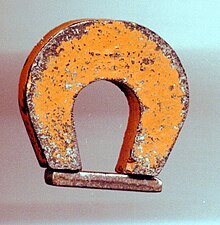Alnico
Alnico are alloys of iron with aluminum , nickel and cobalt as well as copper . Permanent magnets are made from them by casting or sintering . One trademark is OERSTIT (Thyssen Edelstahlwerke AG).
history
The material was first produced in 1931 by the Japanese metallurgist Tokushichi Mishima . While working with iron-nickel alloys (“silver sheet ” or nickel steel ), Mishima discovered that the addition of aluminum results in permanent magnetic properties in the alloy. It achieved a coercive field strength of 32 kA / m, which was a lot for the conditions at the time and was sold under the English trademark MK Magnetic Steel, MKM Steel .
Alnico alloys with improved magnetic properties are achieved by adding copper, cobalt and titanium and consist of 8–12% aluminum, 15–26% nickel, 5–24% cobalt, up to 6% copper and up to 1 by volume % Titanium. The main part of the alloy is iron. The specific proportions vary depending on the requirements of the material.
properties
The remanent flux density of commercially available Alnico is around 0.6 T to 1.3 T (6000-13000 Gauss ) and is relatively high compared to ferrite magnets . As with other permanent magnets, the flux density on the surface of the magnet is usually significantly lower. AlNiCo magnets have a Curie temperature of 700–850 ° C and an upper service temperature of 450–500 ° C.
The material is becoming less and less important and is being replaced by rare earth magnet materials such as neodymium-iron-boron . One reason is that Alnico has poor magnetic stability. This means that the coercive field strength of Alnico is comparatively small in comparison with rare earth magnets of around 50-100 kA / m and the risk of demagnetization by an external field is relatively high.
Permanent magnets made of AlNiCo have a longer shape than those made of hard ferrite.
One advantage of AlNiCo is that it has a stable magnetization after artificial aging. Of all known materials, it has the lowest temperature coefficient of remanence induction. That is why AlNiCo magnets are still used in sensors . Traditional speakers and guitars tonabnehmer ( pickups ) also use alnico magnets while in electric motors were replaced with permanent excitation by ferrite magnets and rare earth magnets. Nickel steel was also used in watchmaking.
An important application are cases with high operating temperatures or (as a magnetically semi-hard material, which is constantly being magnetized) hysteresis brakes , in which the high Curie temperature is important in order to withstand the thermal load.
Individual evidence
- ^ Peter Campbell: Permanent magnet materials and their application . Cambridge University Press, UK 1996, ISBN 0-521-56688-6 , pp. 35-38.
- ↑ http://www.tridelta.de/viomatrix/imgs/download/oerstit-d.pdf
- ↑ https://www.trademarkia.com/oerstit-72136745.html
- ↑ Tokushichi Mishima MK Magnetic Steel. (No longer available online.) Archived from the original on August 13, 2013 ; Retrieved June 19, 2013 . Info: The archive link was inserted automatically and has not yet been checked. Please check the original and archive link according to the instructions and then remove this notice.
- ↑ BD Cullity, CD Graham: Introduction to Magnetic Materials . Wiley-IEEE, 2008, ISBN 0-471-47741-9 , p. 485.
- ↑ Maurer Magnetic AG: Interesting facts about magnetic materials ( Memento of February 3, 2013 in the Internet Archive ) (PDF; 336 kB)
- ↑ a b Permanent Magnetic Materials (PDF; 87 kB) ( Memento of the original from June 13, 2013 in the Internet Archive ) Info: The archive link has been inserted automatically and has not yet been checked. Please check the original and archive link according to the instructions and then remove this notice. at Permagsoft.com, accessed January 13, 2012.
- ^ Hans F. Tölke: Nickel steel. Charles-Edouard Guillaume died 50 years ago. In: Old clocks. No. 2, 1989, pp. 59-62.
